“We Needed to Protect and Take Care of Our Home Country”, Former Unit Leader Says
Witness Chuon Thi took his stance for the second day. He told the court about the conflict with Vietnam. He repeatedly stressed that Democratic Kampuchea was defending itself from Vietnamese incursions and that they did not encroach on Vietnamese territory. He also gave evidence regarding the regulation of marriage and testified that people were not forced to marry someone if they disliked that person.
Marriages
In the morning, witness Chuon Thi continued his testimony. The floor was granted to the Khieu Samphan Defense Team. Ms. Guissé sought clarification regarding his training sessions and Principle 6 of the 12 Moral Principles. Mr. Thi confirmed having attended training sessions regarding this topic, but he could not remember the exact principle. Ms. Guissé read out the principle.[1] Ms. Guissé asked whether he remembered any conditions that were supposed to govern the marriage. He replied that once the arrangements were made, “no one could refuse it.” Ms. Guissé asked whether he personally arranged marriages where people indicated that they were not in agreement. He replied that the arrangement was “not in a rush” and that both parties had to consent to the agreement. “They had to understand each other’s feelings. […] If people did not like each other, they did not have to go through the process and they could return to the respective units.”
Once both parties consented, the marriage process would take place. If they did not like the arrangement, they “could walk away,” he said. “There was no forced marriage.” Ms. Guissé said that he had told the investigators that some people had told him that they were forced to marry. She asked who had told him this.[2] He replied that “it did not happen in my unit.” He said that he had not heard that people were forced to get married.” Thus, “people were not forced to marry at all.”
Ms. Guissé wanted to know whether he received particular instructions to monitor couples in order to force them to consummate their marriage. He answered that “the upper echelon never instructed us, in particular in my unit, to force couples who did not like each other to marry.” He said that couples were not monitored whether they consummated their marriage. Ms. Guissé said that a few people had testified that they were monitored. She asked whether he had heard of a policy regarding this matter. He answered that he had not heard of such instructions, but he did not know what happened in other parts of the country. He explained that there were two scenarios how weddings would come into place: first, if the couples knew each other, they could ask the chairperson for permission to marry. Second, they could approach the chairperson if they had not found a partner and ask the chairperson to select a spouse for them. They would then be introduced to each other.
Ms. Guissé asked how many marriages he had arranged. Those who had already contacted each other would give them their names. Those who “were shy” relied on the unit leader to select their spouses. If they did not like it, both men and women could walk away. He arranged around 15 to 20 couples to get married. Ms. Guissé asked whether he knew why collective instead of individual wedding ceremonies were arranged. He answered that he was not certain of the reason, but that “it would take a long time” if they were to be arranged individually. “The mass marriage took place […] in the interest of time,” he said.
Some people did not agree to marry, to which he had answered at the time that “nothing would happen” if they disagreed.
When he was at the military barrack, some people spoke about forced marriages. “I was told that there was a mismatch,” and they had to return to their respective units. This happened to the civilian population and not the military personnel.
The Khieu Samphan Defense Counsel then asked whether he remembered the topics that Pol Pot addressed in June 1978 at a training conference. He replied that it took place in Kampong Chhnang. Pol Pot had talked about “the construction of the country.” He was there only for a brief period of time before having to mobilize his forces for the border.[3] Ms. Guissé referred to his statement, in which he had talked about Pol Pot’s speech. She asked whether he was present when Pol Pot talked about agricultural production. He said that Pol Pot had talked about increasing agricultural production and defending their borders. He explained that he heard some parts of the message, but that he was not there constantly. He did not know whether they discussed the issue of food given to the people.
He said he joined the attack in Svay Rieng in June. Ms. Guissé asked whether Pol Pot had said that the population had to be increased through arranged marriages. He replied that this was the case. He said that he did remember.[4] She asked whether he had heard about the issue of increasing the population. He said he had. Ms. Guissé asked whether he had heard of the aim to increase the living condition of the population. He replied that he had heard of it. There were discussions that if people had enough to eat, living conditions would be better and the economy would improve. In the event of the conflict with Vietnam, he lost three of his siblings. With this, Ms. Guissé concluded her line of questioning.
Marriage
The floor was handed to the Co-Prosecutors. Senior Assistant Prosecutor Dale Lysak started his line of questioning by asking about his marriage.
He replied that the wedding was organized by the leadership and could be arranged if they wanted to get married. This started after 1976 and 1977.
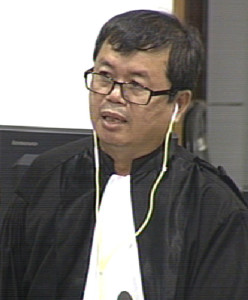
Khieu Samphan Defense Counsel Kong Sam Onn
Mr. Lysak quoted his statement, in which he had said that they had to increase the number of marriages to improve the population.[5] Mr. Lysak asked how the population could be increased “so dramatically” (from 7 to 20 million) if at the time people were already allowed to marry. He asked what they were going to do to increase the number of marriages. Khieu Samphan Defense Counsel Kong Sam Onn objected and said that the question was repetitive. The objection was overruled. Mr. Thi answered that those who had already been married would not be married again. Mr. Lysak repeated the question. Mr. Thi answered that weddings were organized so that the population could be increased.
Military Background
Mr. Lysak asked Mr. Thi about Regiment 16 commander and Deputy Commander of Division 1 Meas Voeun. Mr. Thi replied that he did not know the individual. At the time, he saw Ta Soeung, “who was leading the force.”
Mr. Lysak asked about Battalion 180 and wanted to know whether this was the witness’s battalion.[6] He answered that he was in regiment 15. There were battalions 121 and 122 in this regiment. Mr. Lysak asked whether he and his forces questioned Pol Pot’s decision to send forces to Svay Rieng. He answered that Pol Pot was a leader and could therefore send the armies anywhere.
Mr. Lysak then wanted to know whether Thy Poussey also came from West Zone Division 1. Mr. Thi answered that Thy Poussey came from the Southwest. He did not know how many soldiers he brought with him. Mr. Lysak asked whether any of the soldiers in Division 340 came from the East Zone military. The witness denied this.
He confirmed that the divisions were re-organized.[7] He had not heard of the names before, since they came from the Southwest Zone.
He did not know whether the other troops had already arrived. He answered that he “did not grasp the situation”, as no announcement was made as to which divisions had arrived already. The areas that he fought in against the Vietnamese was from the east of Svay Rieng until the Bavet area. At that time, no civilians lived there. At that time, Vietnamese troops retreated from Svay Rieng to Bavet. He said his forces were based to the east of Svay Rieng area in Vay Koh and not in Bavet. He confirmed that they would go closer to the border if necessary. Thy Poussey and the witness were stationed in Svay Rieng in their office. They were assigned a spearhead to counter the Vietnamese advancement.
Mr. Lysak quoted a regiment commander of Division 730 and asked whether Ren was stationed at an airfield west of Svay Rieng.[8] Mr. Thi replied that he was not sure, since he met Ren outside of his office.
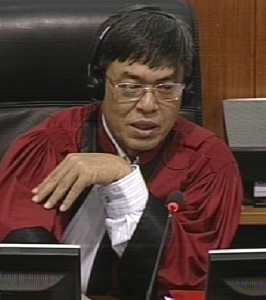
Trial Chamber President Nil Nonn
Mr. Lysak asked whether he remembered the location Kraol Kou and where this was located. He answered that they were stationed in Svay Rieng. He did not know who was based in Kraol Kou. The area that he stayed in was part of P’chum Poktea to the north of Svay Rieng Provincial Town.
At this point, the President adjourned the hearing for a break.
Counterattacks
After the break, the Deputy Co-Prosecutor referred to the Written Record of Interview of the commander of the Intervention Brigade 221.[9] He said that the battalion was under the command of Ta Ren and that it was to reinforce the battalions. The Intervention Brigade engaged in normal combat, but would reinforce forces when situations became difficult.
Mr. Lysak asked whether there was any movement in the battle between June 1978 and beginning of 1979. He replied that the situation was “really tough”, since the Vietnamese were attacking them and the Cambodians counterattack them. “They used artillery to shell us.” Before the “yuon attacked the country,” they were fighting each other.
Mr. Lysak referred to a May 1978 report that indicated that the civilian population moved to rear basis in month before witness arrived.[10] He replied that he did not “see a single person or villager” when he arrived. Mr. Lysak asked whether he remembered the communications office in Svay Rieng and where it was located if he did.[11] He replied that he did not know about this. His troops and the Vietnamese were fighting on a daily basis. There were only a small number of injuries and fatalities in the six months that he was stationed there. “We did not attack one another in an open contact.” After the invasion, they fled to different directions. Some soldiers were brought to the hospital. There were aerial attacks, but he was not transferred to another area. They were fleeing. He did not know the types of planes and could only hear their sound. His unit did not have any aircraft and had only weapons to attack the infantry. They did not have time to lay mines when the Vietnamese invaded the country. The witness explained that they did not lay mines and no spike traps in his area, but some at the border. Mr. Lysak read an excerpt of a document that indicated that 1,635,380 spike traps were laid.[12] He said that spike traps were made from bamboo wood and laid out of their lines. His unit was located far from the border, which was why his unit did not lay any spike traps. In Svay Rieng, spikes were places not that deep.[13] They were used to wound soldiers. He did not know whether many soldiers got wounded by the spike traps. Mr. Lysak then inquired whether any of his division engaged into any combat that took place inside Vietnam. Mr. Thi denied this and said they were merely defending the country.
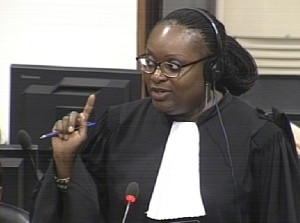
Khieu Samphan Defense Counsel Anta Guissé
When Mr. Lysak inquired about Cambodian incursions into Vietnam, Mr. Koppe objected and said it was outside the scope of this trial. Khieu Samphan Defense Counsel Anta Guissé supported her colleague and said that it was also outside scope of his knowledge. Mr. Lysak said it was not outside the scope. The incursions were not part of crimes themselves, but related to armed conflict. The Closing Order specifically included incursions into Vietnam (paragraph 153). The objection was overruled.
Mr. Lysak wanted to know whether Tay Ninh was the Vietnamese Province on the Vietnamese side of the border at Bavet.[14] The witness replied that he never entered Vietnamese territory and was therefore not knowledgeable in geography. Mr. Lysak asked whether one of the divisions under Ren was Division 460 commanded by Phorn from the Southwest Zone. He answered that he came from the Southwest Zone. Mr. Lysak read an excerpt of another witness, who had talked about entering Vietnamese territory. Mr. Lysak asked whether he had heard of the brigade commanded by Ta Nor.[15] Mr. Thi denied this.
Divisions
Mr. Lysak said that a report showed an incursion of his Division 340 and Special Intervention Brigade 221 into Vietnam.[16] Ms. Guissé objected and said that it was not “his” Division 340. Mr. Koppe added that Case 002/02 “is a very big case. We are defending our client on the assumption that we will not be dealing with the incursions.” They had, he said, not prepared for this and checked, for example, the reliability of this commander. Mr. Lysak said that this was “rather remarkable,” since counsel had repeatedly requested to tender into evidence documents that attempted to prove that Vietnam was the one attacking Cambodia and not vice versa. The objections were overruled. Mr. Lysak then read out the document. “We did not enter Vietnamese territory,” Mr. Thi replied. He never went to the location in question.
Mr. Lysak inquired whether any of his soldiers were ever captured by Vietnamese troops. He replied that he “could not grasp the situation at the time.” He said it was possible that soldiers from both sides were captured. Mr. Lysak asked whether the numbers of his divisions were publicly known or only within the military. Ms. Guissé objected and said that the witness had clearly said that his brigade was in one very specific place. To present this as a contradiction was unfair. Mr. Koppe sided with her and said that this report was Vietnamese propaganda.
He said that Division 340 was newly established in 1978 when they were about to fight the Vietnamese troops. He and another cadre were the commanders of this division. He said it was onli known within the military. They did not capture any Vietnamese combatant in the six months that he was stationed there. “How could we capture them? They had guns and they were careful.”
Mr. Lysak pointed to documents that seemed to indicate that Vietnamese soldiers were captured in the Bavet area.[17] “Is it not correct that there were some Vietnamese soldiers who were captured in combat?” Mr. Lysak asked the witness. Mr. Thi answered that he did not understand the situation fully. “My role was to defend the border area.” He insisted: “We never captured any yuon, not at all.” There was a regulation that they should not mistreat any prisoner of war. There was no guideline on where to send captured soldiers. Mr. Lysak inquired whether it was correct that the captured soldiers were first to be sent to Ren in the division headquarters.[18] He answered that it was beyond his duty and role.
At this point, the President adjourned the hearing for a break.
Role of the East Zone
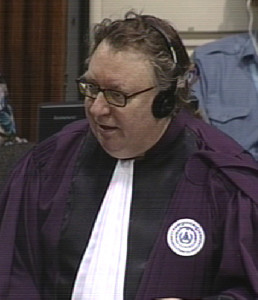
Deputy Co-Prosecutor Dale Lysak
In the first session after the lunch break, Mr. Lysak read an excerpt of a document, which indicated that the Democratic Kampuchean troops killed 422 Vietnamese soldiers and captured a number of combatants as well as items.[19] Mr. Lysak asked whether his division reported to Ren on specific results of combat on the battlefield. He replied that he had not heard announcements, since they did not have a radio. They would, however, report on the lack of weapons and explosives. He recounted that they were only tasked to prevent the attacks by the Vietnamese. Mr. Lysak asked whether he attended any meetings where Ren reported on instructions or whether Thy Poussey reported on such activities.[20] He replied that he had never reported to Ren. He had never heard about the treason of East Zone cadres, since he was “an ordinary soldier.” Mr. Lysak read another excerpt, in which Khieu Samphan had said that the Vietnamese attacks could happen because of treason and that major towns in the East Zone had been seized.[21] The witness could not recall the exact year that the invasions began. They were defeated from that time onwards, he said. “I went to hide myself close to my house to safe my life. I did not dare to go back into the village.”
He was never asked to arrest anyone. In the course of the six months that he was stationed at the border, “no one was arrested and sent to Phnom Penh,” the witness said. Mr. Lysak said that the OCIJ list indicated that a number of combatants from Division 340 were sent to S-21 in that time period.[22] Mr. Lysak asked whether he recognized any of the names on the document. He pointed in particular to Ruot Horn, who entered S-21 in October 1978. He did not know the nine individuals, he said.
In October, he never knew about the invitation to that location and “never knew about the arrest of disappearances.” If a commander had been arrested, he would have learned about this, he said.
Mr. Lysak asked about a construction of an airfield at Kampong Chhnang. He replied that he had heard of it, but did not know anything about it. His soldiers were not sent to build the airfield in Kampong Chhnang.
He unit “came to fight the yuon at the border.”[23] As for the communication toward the upper level, he replied that Thy Poussey and he only rarely communicated with the upper echelon. They did not use radio or telephone and only used messengers for communication.
Meetings
Mr. Lysak moved on and inquired about annual congress meetings. Mr. Thi answered that he did not participate in the meeting itself. He did not know whether it was an annual meeting. Mr. Lysak quoted his statement, in which he had talked about annual meetings. He confirmed that there were meetings, but that military personnel were on missions sometimes and could not attend.[24] These kind of meetings were therefore not mandatory for the military personnel, as the meetings were rather about administrative matters. Mr. Lysak asked what missions prevented him from attending the meetings, as he had said that he was working on the rice fields until June 1978. He replied that he was not invited. Mr. Lysak then referred to another witness’s statement, who had mentioned a meeting at a coconut plantation at Chbar Mon.[25] Mr. Thi replied that he never attended any meeting there.
Mr. Lysak asked whether he attended political education sessions and if so, where this was held. He replied that he worked in the rice field and sometimes did not attend meetings for that reason. “I did not attend any political study [session]. The division actually instructed us to engage in rice farming to sustain ourselves, and we were also told to be vigilant; that was all.” They were told to look after the troops and weapons.[26] He was told to look after the soldiers and make sure they had sufficient food to eat. He could not recall the actual locations. Traditionally, Ta Mok did not give any presentation. “He only came to ask how the soldiers were doing and whether they had sufficient food to eat.” He knew that the person who came to visit was Ta Mok, since he heard people referring to him with that name. Mr. Lysak read another excerpt of his statement, in which he had said that he attended the meeting in three days.[27] He could not recall this “for sure”, but said that he thought the maximum of days would be two.
He only saw Pol Pot during this meeting. There were many participants. He estimated that the number could be in the hundreds. They were, however, not the “core participants” and did not have a “full content” of the meeting.
Buddhism
Mr. Lysak then inquired whether people were allowed to get married with traditional Buddhist ceremonies. Mr. Thi answered that “to [his] knowledge, it was not organized according to the tradition. It was indeed organized according to the way I described this morning.”[28] Mr. Lysak asked why there were no monks and pagodas during Democratic Kampuchea, as he had indicated in his statement. He replied that he himself “did not know”. “I was not a leader, so I could not know about their leading policy. I simply followed what I was told”. Mr. Lysak asked whether he received similar training regarding the elimination of religion.[29] Mr. Thi answered that they never heard about the elimination of religion “at all”. “The discussion was to join our hands to defend our country and to do what we needed to do in order for Samdech Sihanouk to return to the country.”
Mr. Lysak asked for extra time, but the presiding judge informed him that they had already granted extra time during the lunch break.
Mr. Lysak then provided a document to the witness. Mr. Lysak referred to another report and asked whether this was the two day meeting he attended.[30] He replied that he did not know. Mr. Lysak asked about the number of couples that were married. He asked whether his unit had to report to the upper echelon on who was married. Mr. Thi answered that the weddings were arranged after they already sought approval of the upper echelon, so they did not need to make any additional report.
Mr. Lysak read his statement: “For example, in my unit, I had to report the number of couples to the upper echelon. Other units did the same.” Mr. Lysak asked how he reported the number of couples every month.[31] As for the reports before the wedding, he explained, certain number of couples were requested to the upper echelon. Subsequently, they did not have to report anything, since they had put that in the report already.
Enemies
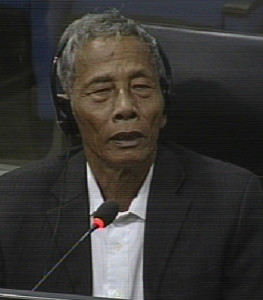
Witness Chuon Thi
Mr. Lysak quoted from the same statement and asked whether there was discussion about enemies of the regime in the meeting that he attended. He replied that he was in a meeting for one or two days. “There were a lot of issues discussed at the time, and I had already left. After the two days, I did not know what topics were discussed.” Mr. Lysak pressed on and inquired about his statement that they were asked to be vigilant towards enemies. Mr. Lysak asked whether this refreshed his memory.[32] He replied that he could not remember. Mr. Lysak read out a report in the months following the June 1978 meeting with Pol Pot.[33] The Deputy Co-Prosecutor asked whether he had heard of a policy with regards to the Vietnamese people who remained in the country. He answered that he did not receive any plan on “how many [yuon] or Chinese to be smashed.”
“I was part of the West Zone army. The army of the sector and the zone were under different commanders. The zone leaders never told me about the Chinese within the Zone Army. I was not aware of it.” With this, the Co-Prosecution concluded its examination of the witness.
At this point, the President adjourned the hearing for a break.
Questions about Arrests and Executions of Khmer Soldiers
In the beginning of the next session, Mr. Koppe asked what happened if Vietnamese troops captured Khmer soldiers. He replied that he only referred to his own unit. None of his soldiers were captured by the Vietnamese. Mr. Koppe asked whether he had heard of other units in which Khmer soldiers were captured. He replied that he did not hear the Vietnamese troops arrested Khmer soldiers before he went to the border. His commander had told him that the Vietnamese had entered Cambodian territory and that they had to be vigilant, but he had not heard of arrests. Mr. Koppe referred to Philip Short’s book, in which the author had said that Vietnamese soldiers “poured over the border” from Svay Rieng to Snuol in the north, meeting not much resistance for the first week. Short wrote that Khmer Rouge soldiers systematically executed Khmer Rouge soldiers in December 1977.[34] He heard that “the border situation at the east was not great.” He was not told any further reason for that.
Prisoners of War
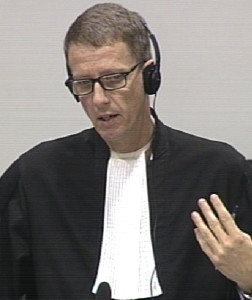
Nuon Chea Defense Counsel Victor Koppe
Mr. Koppe read an excerpt of Nayan Chanda’s book. It was indicated that the Vietnamese bombed Cambodia thirty times a day.[35] Mr. Thi answered that he did not know how many times they were bombarded. He could not recall the exact situation and that the distance between Svay Rieng and Snuol was far. He did not know how many bombardments took place per day. Mr. Koppe referred again to Chanda’s work: “Within four months […] a string of secret camps had sprung in South Vietnam to […] train a guerilla army.”[36] He said that there those who opposed the Democratic Kampuchea regime. “We never arrested any insurgents,” he told the court. When he arrived in Svay Rieng “there was no rebellious activity at all” in the east.”
This prompted Mr. Koppe to read another excerpt of the book and asked whether he had ever heard about East Zone forces belonging to Heng Samrin had been hiding in the forest.[37] The witness denied this. “I did not hear anything about this.” Asked about this again, he repeated that he was not informed about this matter.[38] Mr. Koppe asked whether he knew from which military region the Vietnamese troops came from. He replied that he did not know about their structure.
Mr. Koppe asked whether he was aware that the troops belonged to the Seventh Military Region whose commander was Tran Van Tra.[39] He did not have any knowledge about the military troops, he said, except that they came from National Road 1.
Mr. Koppe said that an Australian expert (Stephen Morris) had written in his book that there were “frequent clashes” between the Cambodian and Vietnamese troops.[40] Mr. Koppe asked whether this was something he would have heard. He said that he could not provide details on this.
Leadership
Moving on to his next topic, Mr. Koppe inquired about his statement that he talked to Son Sen about the situation with Vietnam. He replied that he had mentioned that they spoke to Son Sen. However, he could not recall that the Vietnamese entered the country. He could recall that he talked to Son Sen about the situation with Vietnam. From what he heard from Son Sen, “he said that the yuon entered our territory and that our troop number was less than them and our weapon number was also less than them.”
Mr. Koppe quoted another document, in which Son Sen said that they would only defend their country from Vietnamese invasions and not provoke them.[41] In the meeting that he attended, Son Sen had mentioned the efforts to protect Cambodia. “He said we needed to protect and take care of our home country.” He did not mention these exact words to them.
Mr. Koppe read an interview of another witness, who had quoted Son Sen or Ta Mok (which was not clear in the interview itself) as having said: “We must defend our territory and we must be patient. Do not fight back when they fire off a few shots […]. Remain calm.”[42] He confirmed that this was the instruction at the border. The situation “became tough” at the border. “We were told to be ready.”
Mr. Koppe referred to a Revolutionary Youth Magazine of August 1975 and asked whether the policy as to how to react to Vietnamese troops was “always crystal clear to all cadres.”[43] He replied that he heard that “we did not have to cause any problems to other countries” and that they “did not have to go into other countries.”
Mr. Koppe quoted another testimony, in which the witness had said that they had to “contain” the enemy. Judge Claudia Fenz asked whether the witness always used the same word in Khmer, which Mr. Koppe denied and then rephrased the question. He explained that when they were attacked by the enemy, they “had to be the master of our own.” The word “mastery”, he said, meant to control their own forces and to try to control the situation. “The upper echelon was not with us all the time, so we needed to be masters of our own.” When the Vietnamese attacked, they had to flee.
With this, Mr. Koppe concluded his line of questioning and the witness’s testimony came to an end. The president thanked the witness and dismissed him.
Oral Submissions
Next, oral submissions regarding a Nuon Chea Defense Team request to admit documents were heard.[44] Mr. Koppe said that they had obtained two articles from DC-Cam from the Searching for the Truth Magazine of July 2015 regarding a further bodyguard and grandson of Sao Phim, as well as a messenger and driver of Sao Phim. They had been made aware of this publication in the 9 September ECCC media clippings.
Mr. Lysak replied that they did not have any objections to the admissions of the DC-Cam articles, with the requirement that “some effort should be made” to provide the full interview with the people. The Civil Party lawyers deferred to the chamber’s witness. The Khieu Samphan Defense Team also had no objection. Mr. Koppe said that they were in the process or trying to acquire the underlying documents.
Mr. Koppe said they would “withdraw this request immediately” if they were to call the testimony of Heng Samrin and Uk Bunchhoeun, since they were much more important witnesses. The President adjourned the hearing. It will continue tomorrow at 9 am with the testimony of 2-TCW-1045.
[1] E3/765, at 0540024 (FR), 00539994 (EN), 00376493 (KH).
[2] E3/10713
[3] E3/4593.
[4] E3/1073.
[5] E3/10713, at answer 21.
[6] E3/9738, at answer 15.
[7] E3/419.
[8] E3/361, at 00194471 (KH), 00766457 (EN), 00268889 (FR).
[9] E3/4593, at answer 12.
[10] E3/862, at 00021019 (KH), 00185207-08 (EN), 00814597 (FR).
[11] E3/426, at 00357492 (KH), 00364071 (EN), 00403068 (FR).
[12] E3/862, at 00021020 (KH), 00185208 (EN), 00814598 (FR).
[13] E3/216, at 2.1.b.2.
[14] E3/3960, at 00054862-63 (KH), 00633897-98 (EN), 00403373-74 (FR).
[15] E3/376, at 00270173-74 (KH), 00278690-91 (EN), 00486094 (FR).
[16] E3/1608, at 00810114 (KH), S00013179-80 (EN), 00793493-94 (FR).
[17] E3/8403, at 00744492 (KH), 00749682 (EN), 00419636 (FR); E3/1322.
[18] E3/361, at 00194469 (KH), 00766454 (EN), 00268887 (FR).
[19] E3/294, at 00170239 (EN).
[20] E3/419, at answer 12; 2-TCW-1046.
[21] E3/3751,
[22] E3/10604; 1044, 4171, 5208, 5858, 7909, 8286, 9562 12307-12308, 12555, 12559, 12840-41, 1405-07, two numbers missing; E3/10205.
[23] E3/421.
[24] E3/10713.
[25] E3/80.
[26] E3/10713, at answer 62.
[27] E3/10713, answers 60-61,
[28] E3/10713, at answer 37.
[29] E3/428, at 00373488 (KH), 00374952 (EN), 00485479 (FR).
[30] E3/1094, at 00143611-12 (KH), 00315376 (EN), 00593532 (FR).
[31] E3/10713, at answer 30.
[32] 24 April 2014, at 11:18.
[33] E3/1094, at 00143610 (KH), 00315374-75 (EN), 00593530 (FR).
[34] E3/9, page 377.
[35] E3/2376, at 00192503 (EN), 00191660 (KH), 00237154 (FR).
[36] E3/2376, at 00192403 (EN).
[37] Ibid., at 00192440 (EN), 00237111 (FR), 00191597 (KH).
[38] Ibid., at 00192439 (EN), 00237110 (FR), 00191596 (KH), page 254.
[39] At 00192378 (EN), 00191525 (KH).
[40] E3/7338, at 01001722 (EN).
[41] E3/799, at 00323916 (FR), 00083160 (KH).
[42] E3/8752, at 00849510-11 (EN), 01309292 (FR), 00733339 (KH).
[43] E3/749, Revolutionary Youth Nr. 8, 00532686 (EN), 00593942 (FR), 00399114 (KH).
[44] E448.
Featured Image: Witness Chuon Thi (ECCC: Flickr).
